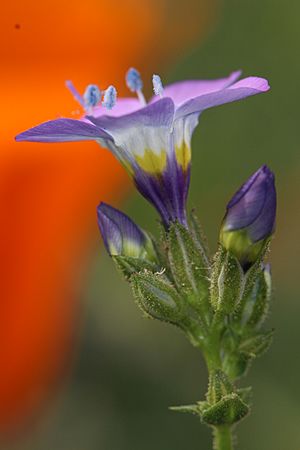Hollyleaf gilia facts for kids
Quick facts for kids Hollyleaf gilia |
|
|---|---|
 |
|
| Scientific classification | |
| Genus: |
Gilia
|
| Species: |
latiflora
|
The Gilia latiflora, also known as the hollyleaf gilia or broad-flowered gilia, is a beautiful flowering plant. It belongs to the phlox family. This plant is special because it is endemic to a specific area, meaning it naturally grows only in the deserts and mountains of southern California and a small part of nearby Nevada.
About the Hollyleaf Gilia
The hollyleaf gilia adds lovely lavender colors to the spring wildflowers that grow like a carpet in sandy areas. Imagine a field of purple flowers! This plant starts with a group of leaves at its base, called a basal rosette. These leaves are a bit frilly and have many narrow, tooth-like edges.
What Does it Look Like?
Instead of a tall stem, the hollyleaf gilia sends flower stalks directly up from the ground. These stalks are called inflorescences. Each flower stalk has many branches and can be green or reddish. They can grow up to about 20 inches (half a meter) tall.
The flowers themselves are quite pretty and smell nice! Each flower has a small green part at its base called a calyx, which is usually a bit sticky. The main part of the flower, called the corolla, is like a tube and can be about 0.3 to 1.4 inches (9 to 35 mm) wide. This tube is purple. The top part of the flower and the bases of its petals are white, fading into a lovely lavender color at the tips.
Inside the flower, you'll usually see five stamens sticking out. These are the parts that make pollen. There's also one longer part called a style, which is part of the plant's reproductive system.
Where Does it Grow?
This plant loves the warm, dry climates of the desert and mountain regions. You can find it in places like the Mojave Desert and the Transverse Ranges in California. It's a key part of the natural plant life in these areas, especially during spring when it blooms and adds a splash of color.

